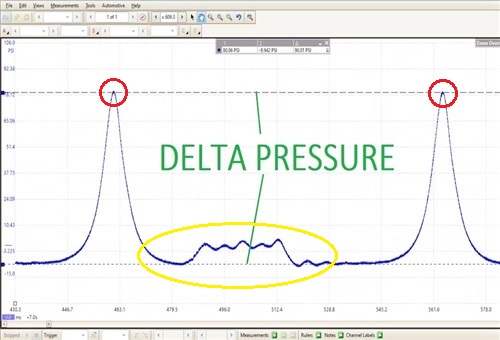
This writer was recently reminded of how true the saying that "knowledge is power" really is when he observed first-hand, the effects of another saying, "…a little knowledge can be a dangerous thing". We need not delve into the finer details of the case here, beyond saying that this writer observed how a relatively inexperienced technician destroyed the hugely expensive engine control module in a high-end Italian sports car when he chose to perform some “tests” on the ignition driver circuits in the module during severely misguided attempts to diagnose a sporadic misfire.
Despite the guidance of the most senior technician in the workshop, the hapless technician instead chose to rely on his knowledge of complex electronic circuits. However, had he used the knowledge that proper diagnostic tools would have given him, he would have found the power to identify an intermittently failing fuel injector as the cause of the problem, and not as he thought, a defective ignition driver circuit. According to reliable sources, this technician now works in the fast-food industry.
In this article, we will discuss the relationship between diagnostic tools, our theoretical knowledge of vehicles, and the power that our tools can give us to draw appropriate diagnostic conclusions and make valid inferences. Before we get to specifics, though, let us look at-
While it could be argued that given the increasing complexity of modern vehicles, one can never own enough diagnostic equipment. However, the high costs of acquiring, maintaining, and updating a large arsenal of diagnostic tools, some of which we do not use every day, is without a doubt the single biggest problem with the fact that there is now a diagnostic tool available to diagnose almost every conceivable problem, defects, or issues on almost any vehicle.
Despite their high cost, though, many of us own multiple tools not because they are nice-to-haves, but because we need multiple tools to remain competitive in today’s highly professional car repair environment. Therefore, many of us, including this writer, own several high-end generic and manufacturer-specific scan tools, dedicated tools to scan, diagnose, reprogram, and reset TPMS, to breakout boxes, sensor simulators, current probes, one or more oscilloscopes, and perhaps an advanced oscilloscope-based NVH analyser.
These tools are then complemented by things like relay testers, one or more spectroscopes and/ or hydrometers with which to test various fluids, specialized battery testing tools, and even brake pressure testers/gauges, exhaust gas analysers and one or more thermal imagers.
Of course, not all of us own all of the tools listed here because of their sometimes- prohibitive costs, but one thing that we all have in common is a tendency to develop an overreliance on our tools at the expense of our deductive reasoning and/or critical thinking skills. This is, however, not the same as saying that all diagnostic tools are bad or make us lazy thinkers; far from it, because many issues on modern vehicles cannot be diagnosed without using at least one diagnostic tool.
What we are saying, though, is this: sometimes, the full meaning of the saying "Understanding a question is half an answer" eludes us because when we use our tools, we a) don’t always ask the right questions, or b) we don’t always understand what our tools are trying to tell us. This happens mainly because we don’t always understand our tools’ limitations, as opposed to their capabilities, but what does this mean in practice, seeing that most of us use various diagnostic tools every day, and successfully so, at that?
This question has several possible answers, and none is easy or short. Limited space precludes a comprehensive discussion of all the possible answers here, but suffice it to say that during his four-decades-long career, this writer has observed one common feature of misdiagnoses and/or diagnoses that take an inordinate amount of time to make- regardless of the vehicle make and model, or the involved technicians’ skill level.
In the interest of full disclosure, it must be stated that this writer has made his fair share of misdiagnoses over the past forty or so years. It must also be stated that most, if not all his mistakes happened as a result of not asking the right questions, which is the common feature that most, if not all misdiagnoses made the world over share.
At the risk of putting too fine a point on it, these questions are not so much about what is wrong with the vehicle*, as they are about the best ways to go about a) understanding the nature of the problem and b) not forgetting to think about the problem, as opposed to allowing diagnostic tools to “think” for you. This is an important point because relying on tools too much often prevents us from using our five senses during the diagnostic process.
*The technician who fried the ultra-expensive engine control module knew what the problem was: the engine misfired intermittently. The real problem was that he did not understand which tool(s) to use to diagnose the root cause(s) of the intermittent misfire.
So, from a practical standpoint, this writer has long ago adopted the practice of interrogating the diagnostic process as thoroughly as the customer’s concern(s). This process necessarily varies to suit the circumstances, but for the most part, it includes asking the following questions, which are all based on the fact that diagnostic tools do not always tell a complete story-
Is the problem diagnosable with a diagnostic tool?
Bear in mind that scan tools typically do not detect things like loose radiator hose clamps, leaking heater valves, and other issues that generally do not set fault codes.
If the use of a diagnostic tool is indicated, which tool is best for the job at hand?
If the engine exhibits, say, random misfires, a scan tool will almost certainly extract a random misfire code, and possibly, several additional codes. However, while setting up a multichannel oscilloscope correctly will reveal the presence of random misfires, an oscilloscope will not always reveal the root causes of the misfires.
Can the observed symptoms have multiple, but unrelated causes?
This writer has often seen new mechanics begin to throw parts at problems because their tools told them there were no faults present that seemed to fit the symptoms they see. In cases like this, their mistake is to accept an absence of evidence of a fault, as evidence of the absence of a fault.
The result of a) failing to use the most appropriate diagnostic tools, and b) a failure to use all the capabilities of said appropriate diagnostic tool to interrogate all of the most likely systems in the vehicle that could conceivably produce the observed symptoms, is that the user misses the lesson the tool is conveying.
In cases like this, the tool is telling the user that it cannot find faults with the wrong inputs. For instance, if the user is attempting to diagnose a misfire, and only checks the live data on one possible cause, such as fuel pressure, the time doing so is wasted unless the user also does the following as a minimum-
Saying all of the above may be preaching to the converted, but this writer has consulted on many cases of “un-diagnosable” misfires and other “un-resolvable” issues that were “caused” by inexperienced mechanics failing to register what their tools were telling them, which was that they (the tools) could not find any faults with incorrect or incomplete inputs.
Thus, the lesson is this: use an appropriate tool, and use all of its capabilities and functions to complement your critical thinking and deductive reasoning skills, as opposed to using tools as a replacement for your critical thinking and deductive reasoning skills. Our brains are the best diagnostic tools ever invented, so not using them to the best effect often leads to us missing what our tools are trying to teach us.
Is the chosen diagnostic tool telling me what I need to know?
If we use the example of random misfires again, the problem might be caused by something as simple as a dislodged or perished PCV hose, or perhaps by a leaking intake manifold gasket. In such cases, a preliminary visual inspection, and some simple tests might identify the problem long before you could set up an oscilloscope, which may or may not tell you what you need to know.
This last point is an important one because even though oscilloscopes are justifiably called the king of diagnostic tools, oscilloscopes sometimes do not tell you everything you need to know to diagnose some kinds of problems, which brings us to-
The purpose of this section is not to teach anybody how to use oscilloscopes to the best effect because that would take up more space than we have available here. Instead, the purpose of this section is to attempt to dispel the notion that oscilloscopes are a) difficult to use, and b), that oscilloscope waveforms are difficult, if not always impossible to interpret and/or decipher correctly.
In practice, oscilloscopes can tell the whole diagnostic story and teach us much of what is happening in most automotive systems because these tools offer us a way to visualize electricity as it flows through conductors and components, and with some effort and skill, it is possible to obtain waveforms of any electrical current, no matter its strength or intensity.
Moreover, oscilloscopes also offer us a way to visualize things like pressures, temperatures, and vibrations by attaching attenuators, pressure transducers, accelerometers, microphones, and thermocouples to various types of components that do not generate or use electrical signals. In these cases, the attenuators, pressure transducers, accelerometers, microphones, and thermocouples generate electrical signals that can be displayed on an oscilloscope.
Having said the above, let us look at what an oscilloscope that is set up correctly can teach us about some aspects of an engine’s mechanical condition by considering the image below-

Image source: https://www.vehicleservicepros.com/service-repair/diagnostics-and-drivability/article/21277300/when-tools-become-the-tutor
This actual oscilloscope trace of two successive compression strokes/events contains a lot of useful diagnostic information, including the fact that this particular cylinder is in good mechanical condition but let us look at some of the details in this example-
The term “delta pressure” refers to the range of pressures that occur in a cylinder between compression pressure peaks, which are denoted here by the two horizontal dotted lines that are adjustable, or moveable cursors.
The two small red circles indicate the peak compression pressure, which in this example, is the same* in each compression stroke.
*Note that minute differences in peak compression pressures sometimes occur naturally, and therefore, do not always indicate mechanical issues with an engine. However, somewhat larger cyclical variations that do not always translate into misfires often cause cylinder power contribution imbalances whose underlying causes are often notoriously difficult to identify and/or diagnose with tools other than oscilloscopes.
Nonetheless, the most important details in the example oscilloscope waveform are-
Note that the diagnostic value of traces like this example can be greatly enhanced with the use of piston position overlay software. Depending on the actual program, piston position overlay software indicate the actual positions of the pistons for each cylinder relative to the compression pressure peaks on the oscilloscope’s display screen, along with the engine’s firing order and other useful information, such as the current ignition timing settings and camshaft position(s) in degrees of rotation.
Let us look at another example-

Image source: https://www.vehicleservicepros.com/service-repair/diagnostics-and-drivability/article/21277300/when-tools-become-the-tutor
This is also an actual oscilloscope trace that shows two successive compression strokes/events in one cylinder but in this example, the peak pressures are indicated by vertical cursors, which are the two vertical dotted lines. Note, though, that the two blue dots at the bottom of the frame are spaced 720 degrees apart, which distance represents one engine cycle.
Using vertical cursors makes it possible to measure the distances between the peaks of the fluctuations in cylinder pressure that are caused by the opening and closing of the valves, which is represented here by the pressure fluctuations between the compression pressure peaks. Thus, by referencing camshaft data, it becomes possible to measure the degrees of camshaft rotation between intake valves opening/closing, relative to the opening/closing of exhaust valves.
These kinds of measurements are particularly helpful if you are investigating camshaft-phasing issues because the oscilloscope allows you to see the problem occurring in real-time. However, the biggest advantage of seeing such defects occurring in real-time allows you to distinguish between the various possible causes of camshaft phasing issues.
For example, using another scope channel to mark ignition events relative to compression pressure peaks will either confirm or eliminate timing chain issues as the cause of camshaft phasing issues, as opposed to VVT/VCT actuator issues or low oil pressure being the cause. Of course, acquiring the ability to make such distinctions involves climbing a steep learning curve but once you master the art of waveform interpretation, an oscilloscope will tell the whole diagnostic story.
Equally importantly, it may also teach you to notice, and pay proper attention to small deviations in cylinder-to-cylinder pressures that are frequently only detectable with an oscilloscope, but that can nevertheless have inordinately large effects on the smooth operation of a modern engine, which leaves us with this-
The idea that our tools can teach us lessons in diagnostics may be outrageous to some of us, but if you are new to the car repair industry in general, and to the independent repair industry in particular, like the technician we mentioned at the beginning of this article, it would be wise to take this notion seriously.
The reason for this is simple: most diagnostic tools are computers, and just like the personal computers we use (mostly) for entertainment, diagnostic computers are also subject to the GIGO principle, which states if you put garbage into a computer, you get garbage out. In the case of diagnostic computers, “garbage” would be incomplete or irrelevant inputs, which would yield garbage results in the form of things like “No Trouble Codes Found” messages. This usually happens when a user searches for codes in the wrong mode or uses an unsuitable, i.e., generic scan tool to look for trouble codes on some vehicles and/or systems- as happened with the inexperienced technician we mentioned earlier.
So, while diagnostic tools cannot teach us our jobs, our diagnostic tools can, and often do, tell us that we are looking for the cause(s) of issues in the wrong places, or that we are not looking thoroughly enough, or that we need to use another type of diagnostic tool to diagnose an issue or a defect. Thus, the secret to becoming a more efficient diagnostician is to use the correct diagnostic tool for the job intelligently, but more importantly, to listen to what your tools are telling you.